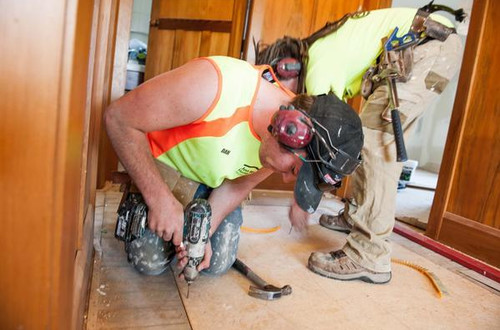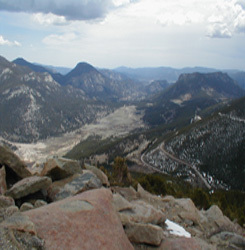
- Capital City:
- Denver
- Nickname:
- Centennial State
- Motto:
- Nil Sine Numine (Nothing without Providence)
- Gained Statehood:
- August 1, 1876 (38th)
- Origin of State's Name:
- From the Spanish for the color red, which was applied to the Colorado River.
- Largest Cities:
- Denver, Colorado Springs, Aurora, Lakewood, Fort Collins
- Border States:
- Arizona, Kansas, Nebraska, New Mexico, Oklahoma, Utah, Wyoming
- Land Area:
- 103,730 sq. mi.; 8th largest
- State Bird:
- Lark Bunting
- State Flower:
- Rocky Mountain Columbine (aquilegia caerules)
- State Tree:
- Colorado Blue Spruce (picea pungens)
- State Song:
- Where the Columbines Grow
Called the "Centennial State," because it became the 38th state when the U.S. turned 100 in 1876. Colorado is most closely associated with the Rocky Mountains and has numerous peaks over 14,000 feet. The state's name comes from a Spanish word meaning "red" or "ruddy," the color of much of the state's terrain. Today, Colorado is known for its vast cattle ranges, agricultural acreage, and snow-covered mountains that are ideal for winter sports. Its capital is Denver and state flower is the Rocky Mountain columbine.
Colorado's Rocky Mountains

Many people know that the Rocky Mountains make up an enormous chain of mountains in western North America that extends 3,000 miles from Canada through the United States to Mexico. But did you know that the tallest mountain in Colorado, part of the Rocky Mountains, is called Mount Elbert, which is 14,433 feet high?
The Rocky Mountains form the Continental Divide, the mountainous ridge that runs north to south along North America and causes water to drain in separate rivers flowing to different sides of the continent. Eventually, these rivers lead to the Atlantic and Pacific Oceans as well as the Gulf of Mexico.
In 1915, Congress designated some of this mountainous area in Colorado as Rocky Mountain National Park. The tallest mountain in this park is Longs Peak, which is 14,256 feet high.
Bolder Boulder Race in Boulder, Colorado
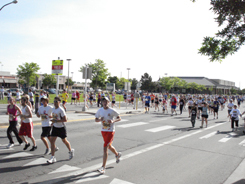
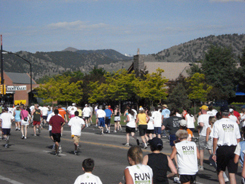
Just like the story about the little train that could, if you think you can, you can. If you can walk, run or wheel, you can take part in the "Oh Yes You Can" race in Boulder, Colorado.
Every year on Memorial Day, Boulder, Colorado, hosts the Bolder Boulder 10K road race. This race is open to everyone and includes a wheelchair race and a walkers' race. It also includes Marine Corps units who march to honor fallen American soldiers. This is the fourth largest road race in the world and the one of the largest tributes to American veterans in the U.S. on Memorial Day.
Because the race is so big, organizers needed to figure out a way to include everyone and still have an official race. So they came up with the idea of the "wave." Runners are placed in "waves," groups of up to 900 people, with staggered start times. Faster runners are put in the first waves and slower ones are placed in the following waves. A new wave is started every one to two minutes, and the start and finish times for the runners in each race are recorded. This way everyone gets to race without the slower runners getting in the way of faster ones. Have you ever been in a race that had "waves"?
Greeley Independence Stampede
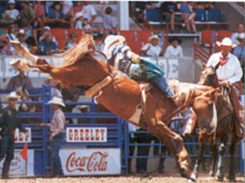
Many American cities have rodeos but Greeley, Colorado, has the "World's Largest Fourth of July Rodeo." The city was named after Horace Greeley, a well-known newspaperman for the New York Tribune. One of his famous sayings was "Go west, Young Man, go west." In 1869, he sent one of his reporters west to Colorado to write a story about farming. The reporter, Nathan C. Meeker, liked the area so much he stayed and started a town named after his boss. It was Meeker's vision that helped establish a successful community based on, among other qualities, cooperation, agriculture, irrigation, and education.
Every year the people of Greeley celebrate Independence Day with a rodeo. In the early days, the rodeo was a small local event, but it grew more and more popular. In 1922, more than 10,000 people came to the rodeo, and the town officially named the event the "Greeley Fourth of July Celebration and the Spud Rodeo and Horseshow." They called it the spud rodeo because spuds (another name for potatoes) are an important crop grown around Greeley. A few years later, even more people came to the rodeo, when famous cowboys started competing with the local ranch hands. Today, the rodeo lasts for two weeks and is called the Greeley Independence Stampede.
Cinco de Mayo
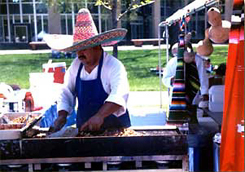
Did you know that Colorado used to be owned by Spain? In the early 1700s the area that is now Colorado was claimed by Spain, and eventually France controlled most of it. Later, in 1803, the Eastern part of Colorado became part of the Louisiana Purchase (a deal between France and the U.S.), with the rest remaining in Spanish, and later, Mexican, control until 1848.
In Denver, Colorado, and many other cities, people of Hispanic and Mexican descent have a Cinco de Mayo festival with storytelling, parades, food, and dancing to the beat of salsa and mariachi music. Cinco de Mayo is Spanish for the Fifth of May. On this day in 1862 Mexican peasants won a battle against French invaders in La Puebla, Mexico. Many people mistake Cinco de Mayo for Mexican Independence Day, but that happened on September 16, 1810 -- more than 50 years earlier.
This Hispanic celebration began in Denver in 1987 as a small neighborhood street festival. By 1996 the weekend event had become so large -- attracting a half-million festival-goers -- that it moved to its new home in Denver's Civic Center Park. Does your city have a Cinco de Mayo celebration? The next time you have the opportunity, go and help celebrate!
Western Welcome Week
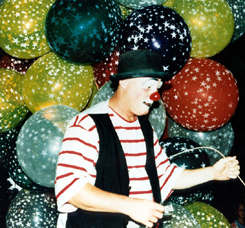
Whether or not the clown in the picture lives in Littleton, Colorado, or is just visiting, he will always be welcome there. That's because if you have ever lived in or visited Littleton you are invited every year to come back for a "homecoming."
The people of Littleton like their community so much they have a big party each year that they call Western Welcome Week. About 1,200 volunteers help organize a circus, parade, fireworks, and more for families and the community to enjoy during this 10-day event.
Houstoun Waring, the longtime editor of the Littleton Independent, founded Western Welcome Week in 1929 as a way to promote the city. His idea was to celebrate the 100th birthday of city founder Richard S. Little with a "Homecoming." Originally Homecoming was set for May 12, 1929, Little's birthday, but when it was pointed out that railroad rates dropped in August and people could come from far away for less money, they changed the date to August, which is when the event is held today.
The Denver March Powwow

Every year American Indians have a powwow in Denver, Colorado, that attracts people from all 50 states and 14 countries. A powwow is a social gathering of Indian peoples to honor their heritage that has been passed down through generations. More than 80 Indian tribes come to the Denver March Powwow to celebrate their history and culture through arts and crafts, storytelling, music and dance.
There are many different types of powwow dances. During InterTribal dancing, everyone from all the different tribes and all age groups dance together. Even though they are dancing as a group, each dancer moves independently to the beat of the drum - expressing his or her own feelings and creating a unique style.
Other dances include the Men's Traditional Dance. This is the oldest form of Indian dancing, and historically only the warriors were allowed to dance in a circle. This dance is a form of storytelling in which the men act out things they have done in battles or on a hunt. In the Women's Jingle Dress Dance, women wear dresses with "jingles" on them and dance in a sort of side-step around a sick person in order to help cure him.
Olathe Sweet Corn Festival
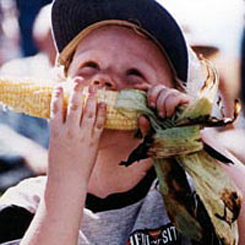
Can sweet corn save a town? It can if that town is Olathe, Colorado!
The town of Olathe used to grow sugar beets and barley, but by the late 1970s those crops weren't in much demand anymore. The town fell on hard times because it depended upon the success of the farmers to survive. Then a farmer named Dave Galinet, who had developed several varieties of sweet corn, decided to move his business to the Olathe area. Olathe had the ideal climate for growing sweet corn - hot days and cool nights. Soon after that, many of the other farmers started to grow sweet corn too, and before long the town was prosperous again.
Olathe decided to celebrate the fact that it was thriving, and what better way than to have a sweet corn festival? The first festival was on a rainy day in August 1992. And guess what? More than 800 people showed up. Nowadays about 20,000 people come to the festival. And you know what they get to do? Eat all the sweet corn they want. In 1999, participants ate 70,000 ears of "Olathe Sweet" donated by the growers. Can you imagine how many people there were to eat that many ears of corn?
Colorado Relocation
If your are considering relocating to Colorado, this Colorado Relocation Guide will give you essential information on Schools, Voting, Drivers License,real estate, etc.
 Print
Print Email
Email



